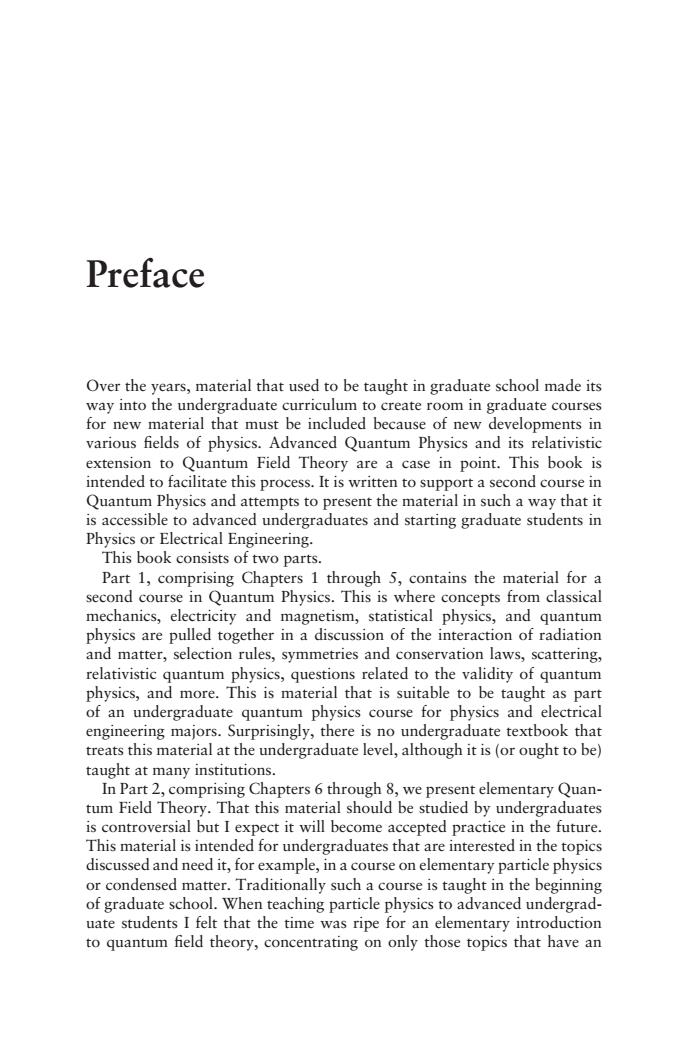正在加载图片...

Preface Over the years,material that used to be taught in graduate school made its 选 ts in extension to Quantum Field Theory are a case in point.This book is intended to facilitate this process.It is written to support a second course in Quantum Physics and attempts to present the material in such a way that it is accessible to adv nced ur dergraduates and starting graduate students in Part 1,comprising Chapters 1 through 5,contains the material for a second course in Quantum Physics.This is where concepts from classical mechanics,electricity and magnetism,statistical physics,and quantum ysics are pulled together n sio of the interaction of radiation aws,scattering, relativistic quantum physics,questions related to the validity of quantum physics,and more.This is material that is suitable to be taught as part of an undergraduate quantum physics course for physics and electrical ngnering majors.Surprisingly,there isno undergraduate textbook that reatsthis material at the undergradu ate level,although it is (or ought to be) taught at many institutions. In Part 2,comprising Chapters 6 through 8,we present elementary Quan- tum Field Theory.That this material should be studied by undergraduates is controversial but I expect it will become accepted practice in the future. This material is intended for undergraduates that are interested in the topics discussed and need it,for exa in a course on elementa ry particle physics or condensed matter. Traditionally such a course is taught in the beginning of graduate school.When teaching particle physics to advanced undergrad- uate students I felt that the time was ripe for an elementary introduction to quantum field theory,concentrating on only those topics that have anPreface Over the years, material that used to be taught in graduate school made its way into the undergraduate curriculum to create room in graduate courses for new material that must be included because of new developments in various fields of physics. Advanced Quantum Physics and its relativistic extension to Quantum Field Theory are a case in point. This book is intended to facilitate this process. It is written to support a second course in Quantum Physics and attempts to present the material in such a way that it is accessible to advanced undergraduates and starting graduate students in Physics or Electrical Engineering. This book consists of two parts. Part 1, comprising Chapters 1 through 5, contains the material for a second course in Quantum Physics. This is where concepts from classical mechanics, electricity and magnetism, statistical physics, and quantum physics are pulled together in a discussion of the interaction of radiation and matter, selection rules, symmetries and conservation laws, scattering, relativistic quantum physics, questions related to the validity of quantum physics, and more. This is material that is suitable to be taught as part of an undergraduate quantum physics course for physics and electrical engineering majors. Surprisingly, there is no undergraduate textbook that treats this material at the undergraduate level, although it is (or ought to be) taught at many institutions. In Part 2, comprising Chapters 6 through 8, we present elementary Quantum Field Theory. That this material should be studied by undergraduates is controversial but I expect it will become accepted practice in the future. This material is intended for undergraduates that are interested in the topics discussed and need it, for example, in a course on elementary particle physics or condensed matter. Traditionally such a course is taught in the beginning of graduate school. When teaching particle physics to advanced undergraduate students I felt that the time was ripe for an elementary introduction to quantum field theory, concentrating on only those topics that have an